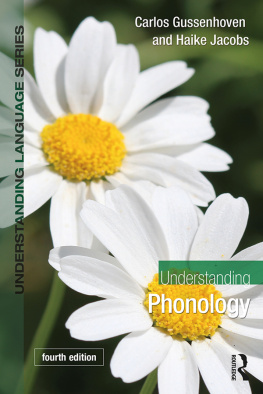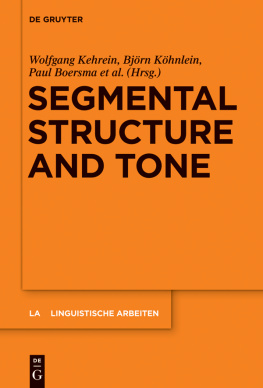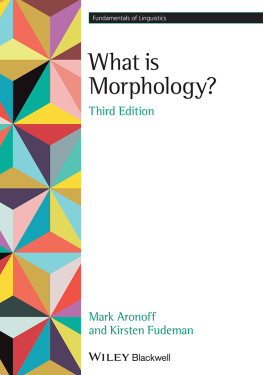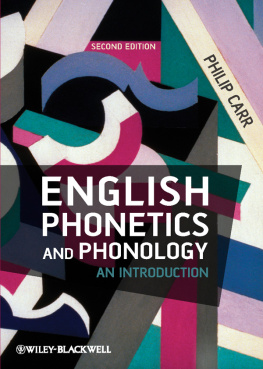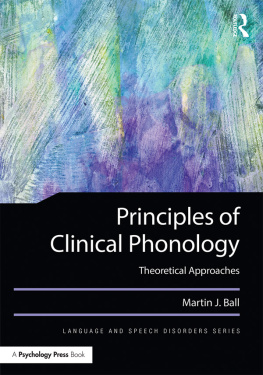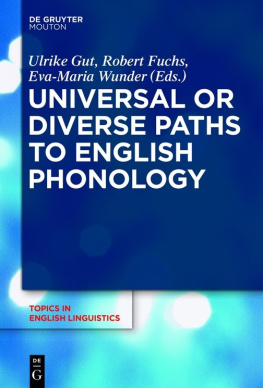Fourth edition published 2017
by Routledge
2 Park Square, Milton Park, Abingdon, Oxon OX14 4RN
and by Routledge
711 Third Avenue, New York, NY 10017
Routledge is an imprint of the Taylor & Francis Group, an informa business
2017 Carlos Gussenhoven and Haike Jacobs
The right of Carlos Gussenhoven and Haike Jacobs to be identified as authors of this work has been asserted by them in accordance with sections 77 and 78 of the Copyright, Designs and Patents Act 1988.
All rights reserved. No part of this book may be reprinted or reproduced or utilised in any form or by any electronic, mechanical, or other means, now known or hereafter invented, including photocopying and recording, or in any information storage or retrieval system, without permission in writing from the publishers.
Trademark notice: Product or corporate names may be trademarks or registered trademarks, and are used only for identification and explanation without intent to infringe.
First edition published by Hodder Arnold 1998
Third edition published by Routledge 2013
British Library Cataloguing-in-Publication Data
A catalogue record for this book is available from the British Library
Library of Congress Cataloging-in-Publication Data
Names: Gussenhoven, Carlos, 1946- author. | Jacobs, Haike, 1961- author.
Title: Understanding phonology / Carlos Gussenhoven and Haike Jacobs.
Description: Fourth Edition. | Milton Park, Abingdon, Oxon ; New York, NY :
Routledge, [2017] | Series: Understanding language series | Includes bibliographical
references and index.
Identifiers: LCCN 2016036736| ISBN 9781138961418 (hardback) | ISBN 9781138961425 (pbk.) |
ISBN 9781315267982 (ebook)
Subjects: LCSH: Grammar, Comparative and generalPhonology.
Classification: LCC P217 .G867 2017 | DDC 414dc23
LC record available at
https://lccn.loc.gov/2016036736
ISBN: 978-1-138-96141-8 (hbk)
ISBN: 978-1-138-96142-5 (pbk)
ISBN: 978-1-315-26798-2 (ebk)
Typeset in Minion Pro and Times New Roman
by Apex CoVantage, LLC
Visit the eResource: www.routledge.com/9781138961425

There are about 7,000 languages in the world today. Almost certainly, no two of them have the same sound structure: they vary widely in the number of consonants and vowels they have, in their use of tonal contrasts, in their stress patterns, in the shape of their syllables, and so on. At the same time, all these languages show striking similarities in the way they structure their sound systems. Phonology is a thriving field of linguistic research that strives to understand the structure behind these systems. How do these similarities arise? And why, at the same time, is there so much variation? How is our knowledge of the pronunciation of our language represented in our brain? How can we describe the pronunciation of a language? What do people do when they play language games? Why do loanwords often sound so totally different from the way they are pronounced in the donor languages? These and many other questions are dealt with in this book. In our discussion, we have tried to sketch the development of scientific thinking about the sound structure of languages and to take an unbiased view of the cognitive or physiological nature of the explanations. We hope we have succeeded in this task in at least some places in the book, and have got close enough to this ideal for it to serve as a reliable and relevant introduction to an important and exciting field.
This book reflects the thoughts and discoveries of many phonologists. We have learnt to appreciate the value and implications of these theoretical positions not only by reading their publications but also by attending their classes and discussing the issues with them. Needless to say, our debt to them is inestimable.
A number of people deserve thanks for providing us with data for the first edition (1998). These are Aoju Chen, Frederic Gaggeri, Kees Groenewoud, Jadranka Gvozdanovi, zden Heebink-Mandaci, Eric Kellerman, Joost Kremers, Aditi Lahiri, Will Leben, Manjari Ohala, Michael Redford, Barbara van den Brekel, Wilber van der Beek, Leo Wetzels and Young-mee Yu Cho.
The second edition (2005) of this book benefited from the comments made by Elan Dresher, San Duanmu, Ed Flemming, Bo Hagstrm, Victoria Rosn, Ingmar Steiner, Rik van Gijn, Jeroen van de Weijer, Leo Wetzels, Maria Wolters and those who responded to the publishers questionnaire.
In the third edition (2011), we made a number of additions and in part rearranged the old text. A new opacity in Optimality Theory. The authors would like to thank Janine Berns, Hyong Sil Cho, Bert Cranen, Anne Cutler, Marinda Hagen, Robert Kennedy, Hikaru Osawa and Henning Reetz for their help with this third edition.
The main conceptual change in this fourth edition (2017) is a more consistent autosegmental treatment of three classes of segments (vowels, consonants and tones) and of their inclusion in the prosodic structure. This has led to a rearrangement of the chapters on syllables, tone and stress, as well as a rewriting of the last two of these chapters. While the functional roles of tones are emphasized throughout the discussion, as a class of segments tones are treated in a single chapter on lexical and intonational tones. The chapter on stress has been expanded and deals with typological issues as much as with theoretical accounts. These rewritings have benefited from the review by David Deterding in JIPA 43 (2013). In addition, we have split the chapter on distinctive features into two, so that students will experience a more even workload across chapters. The new treats place features and includes the rule format conventions that in earlier editions were discussed in a chapter on Dutch diminutives. That chapter has been discarded in this edition. The chapter on underlying and surface representations is now immediately followed by the chapter on Lexical Phonology. Finally, we have collapsed the two chapters on feature geometry into one, and reduced the discussion on opacity. The chapters on opacity and feature geometry are the last chapters in the book. As a result of these changes, the number of chapters has been reduced from 16 to 14. We thank Mirjam Broersma, Hyong Sil Cho, Bernard Comrie, Grev Corbett, Catia Cucchiarini, Gunnar Holmstedt, Judith Hanssen, Beste Kamali, Hamed Rahmani, Makiko Sadakata and Leo Wetzels for comments on a draft version and help with data. Finally, it was an unspeakably reassuring experience to find Helen Tredget and Katherine Wetzel skilfully seeing our manuscript through production.
Carlos Gussenhoven and Haike Jacobs
Radboud University Nijmegen, the Netherlands
July 2016
[at] see
[mju] see
[fa] see
[sgm]; see
BrE [mg]; AmE [meg]; see
absolute slicing hypothesis
accents
accentual analysis
adjustment, phonological
affixes
affricates
airstream mechanisms
Aitkens Law
alignment, tone
allomorph ; morpheme alternant and
allophones
allophonic and stylistic variation
allophonic rules
alveolar
alveolar ridge
alveolopalatal
ambiguity and non-specification, distinctive features
ambisyllabicity
analysis, segment
Andersen, Torben
apical
approximant
aspiration
assimilations
association convention
association lines
autosegments
back (tongue)
back vowels
Beckman, Mary E.
bilabial
bimoraic syllables
binary distinctive features
blade zone (tongue)
bleeding order

